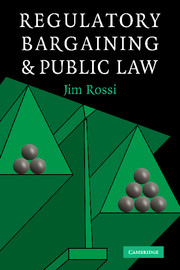Book contents
- Frontmatter
- Contents
- Preface
- Acknowledgments
- 1 The Scope of Regulatory Bargaining
- PART I EXTENDING INCOMPLETE BARGAINS FROM THE ECONOMICS OF THE FIRM TO PUBLIC GOVERNANCE
- 2 Regulatory Bargaining and the Stability of Natural Monopoly Regulation
- 3 The Incompleteness of Regulatory Law: Moving Beyond the “Small World” of Natural Monopoly Regulation
- 4 Refin(anc)ing Retail Service Obligations for the Competitive Environment
- PART II INCOMPLETE REGULATORY BARGAINS, INSTITUTIONS, AND THE ROLE OF JUDICIAL REVIEW IN DEREGULATED INDUSTRIES
- References
- Index of Primary Legal Authorities
- Subject Index
2 - Regulatory Bargaining and the Stability of Natural Monopoly Regulation
Published online by Cambridge University Press: 11 July 2009
- Frontmatter
- Contents
- Preface
- Acknowledgments
- 1 The Scope of Regulatory Bargaining
- PART I EXTENDING INCOMPLETE BARGAINS FROM THE ECONOMICS OF THE FIRM TO PUBLIC GOVERNANCE
- 2 Regulatory Bargaining and the Stability of Natural Monopoly Regulation
- 3 The Incompleteness of Regulatory Law: Moving Beyond the “Small World” of Natural Monopoly Regulation
- 4 Refin(anc)ing Retail Service Obligations for the Competitive Environment
- PART II INCOMPLETE REGULATORY BARGAINS, INSTITUTIONS, AND THE ROLE OF JUDICIAL REVIEW IN DEREGULATED INDUSTRIES
- References
- Index of Primary Legal Authorities
- Subject Index
Summary
During most of the twentieth century, utility firms in industries such as electric power and telecommunications were characterized by two primary features: vertical integration of the industry and regulation of rates based on cost of service. Cost-of-service regulation of telecommunications and energy utilities was firm specific. It occurred primarily in individual state and local jurisdictions as opposed to at the national level and, due to the structure of the industry, applied in governing jurisdictions where a single utility possessed substantial market power. For more than 50 years, traditional natural monopoly regulation worked as a particularized forum for negotiating any tension between public and private interests; individual firms were deterred from engaging in conduct that undermined the regulator because this could have negative implications for their approved rates. Richard Hirsh, a historian of the electric power industry, describes this as “a consensus between utilities and reformers concerning the nature of the American electric utility system” (Hirsh, 1999: 11). The same sort of consensus appears to have also existed in telecommunications (Noam, 1997).
To the extent that the bargain between the firm and government was stable, it is not clear what role public law played for economic regulation during the twentieth century. During the era of natural monopoly regulation, regulators focused their primary attention on governing outputs of the firm (in the form of mandated service prices and quality). These agency decisions were subject to judicial review, but courts largely deferred to agency regulators.
- Type
- Chapter
- Information
- Regulatory Bargaining and Public Law , pp. 31 - 50Publisher: Cambridge University PressPrint publication year: 2005



